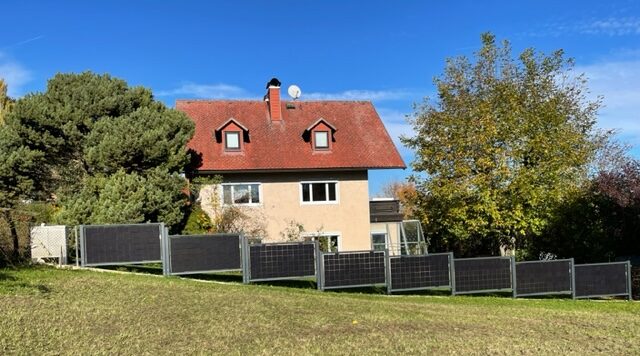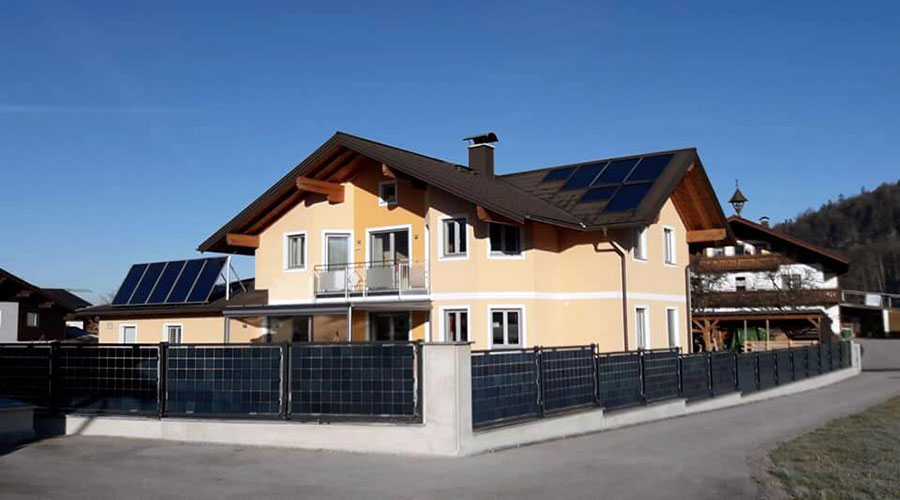The original solar fence from Next2Sun
Known from











Energy self-sufficient with solar fence
In recent years, the use of photovoltaics to generate energy has become increasingly popular, not only because of the latest developments in the energy sector, but also because of the need for energy independence and low-cost self-generation of electricity for heating, self-consumption or electric vehicles.
Traditionally, most photovoltaic systems have been installed flat on roofs or green spaces. However, this method has one major disadvantage: they generate most of their energy at midday. This overproduction during peak hours can lead to an overload of the electricity grids. With its PV fence Fence2Sun, Next2Sun has brought an innovative solution onto the market that, thanks to vertically mounted, bifacial modules, also produces electricity in the morning and evening – i.e. outside the midday peak times – precisely when it is needed most.

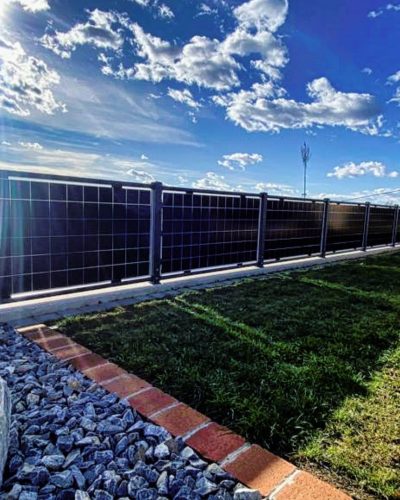
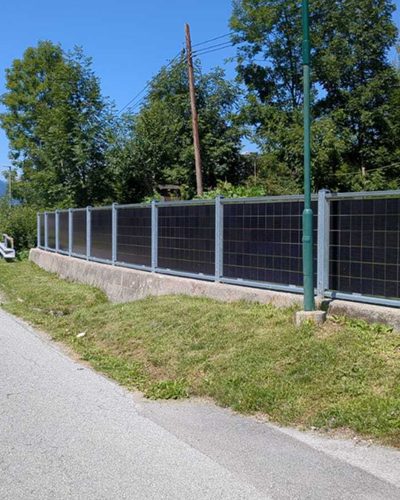
The costs are amortized within 8 years.
From as little as € 250 per meter.
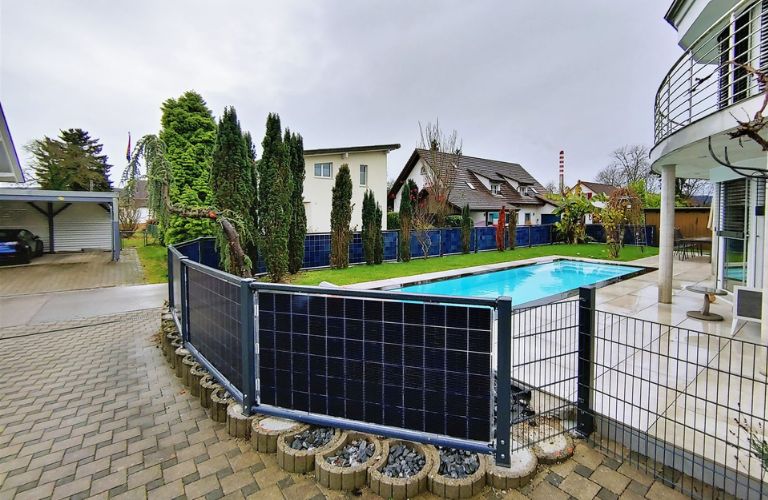
Save money with the solar fence.
Vertical PV systems in the form of a solar fence are the future of energy generation.
The innovative technology from Next2Sun combines progress with functionality in one product.
Not only does it save space, but the bifacial modules also generate up to 10 % more yield.
In addition to independent electricity production, the elements also serve as a privacy screen and boundary for your property.
High-quality materials ensure durability and aesthetics.
Find out how much you can save with a PV fence – calculate your individual costs and potential yield now with our solar fence calculator.
What makes the solar fence
the ideal choice
Efficient energy: Bifacial modules utilise light from both sides for a constant yield, ideal for self-consumption and reducing electricity costs.
Robust and durable: Weatherproof, low-maintenance, with up to 30 years guarantee on modules and 10 years on the frame.
Flexible design: Two versions – elegant for gardens, robust for commercial use – customisable thanks to the modular system for sustainable property upgrades.
The solar fence calculator
Calculate the possible output, the potential annual electricity yield and the rough cost framework of your solar fence here with the help of your personal property conditions! For the yield and cost estimate, we need the entire length of the planned fencing/enclosure with the solar fence.

Become an electricity supplier
- Cover own requirements
- Self-sufficiency from external supply
- Slim design

Driving forward the energy transition
- Grid-compatible feed-in
- Quick and easy assembly
- Innovative electricity production

More electricity yield
- Up to 1200 kWh/kWp/year
- Engineered in Germany
- Above-average product and performance guarantees

High energy self-sufficiency thanks to the solar fence
- Electricity production at times of self-consumption
- Self-assembly and connection possible
- Smaller memory required

Constant power generation even in winter
- No snow build-up on the modules
-
Even up to 1300 kWh/kWp/year
thanks to the albedo effect - Higher yield in winter
Areas of application for the solar fence
Anwendungs-
bereiche
Fence2Sun blends aesthetically into the landscape and ensures economic and ecological sustainability.
The Next2Sun solar fence Fence2Sun can be used around the home as well as on commercial or industrial properties and in agriculture. You profit several times over: on the one hand by enclosing your area or property, and on the other hand by optimized power generation. And if you already have a photovoltaic system on your roof, you can use Fence2Sun to create further potential for generating electricity and diversify your own energy production.





Solar fence for private households
- Covering the needs of a single-family home
- Aesthetic property fencing
- Privacy screen with more electricity yield


For companies & municipalities
- Increase self-sufficiency from external supply
- Easy installation and maintenance
- Significantly better results than conventional rooftop systems


PV fence for farmers
- Protection screen against predators
- Shade provider
- Self-sufficient energy solution
References
Next2Sun’s Fence2Sun has proven to be an effective solution for customers looking for an innovative energy source that also serves as an enclosure.
Solar fence designs for all needs
Enclosures are essential for private, commercial and industrial properties as well as for farms with livestock. Take advantage of the possibilities of bifacial glass-glass PV modules in combination with our fencing system. This turns your fence into an electricity supplier!
Different frame and foundation variants are available in a modular system for the various areas of application:
The premium version, specially developed for the end customer segment and prestigious buildings, includes a visually very appealing and high-quality square version, which is available in galvanized and RAL 7016. The color anthracite is probably the most widely used. The design plays a particularly important role in this version.
The standard version, which is primarily designed for assembly and material efficiency, represents the simpler version of the two variants.
Several variants are also possible for the foundation or erection of the solar fence: installation on concrete foundations or point foundations, wall mounting or pile-driven foundations. Depending on the application and building regulations, both a variant with one row of modules (height approx. 1.2 – 1.6 m) and a variant with two rows of modules (height > 2.3 m) can be used.
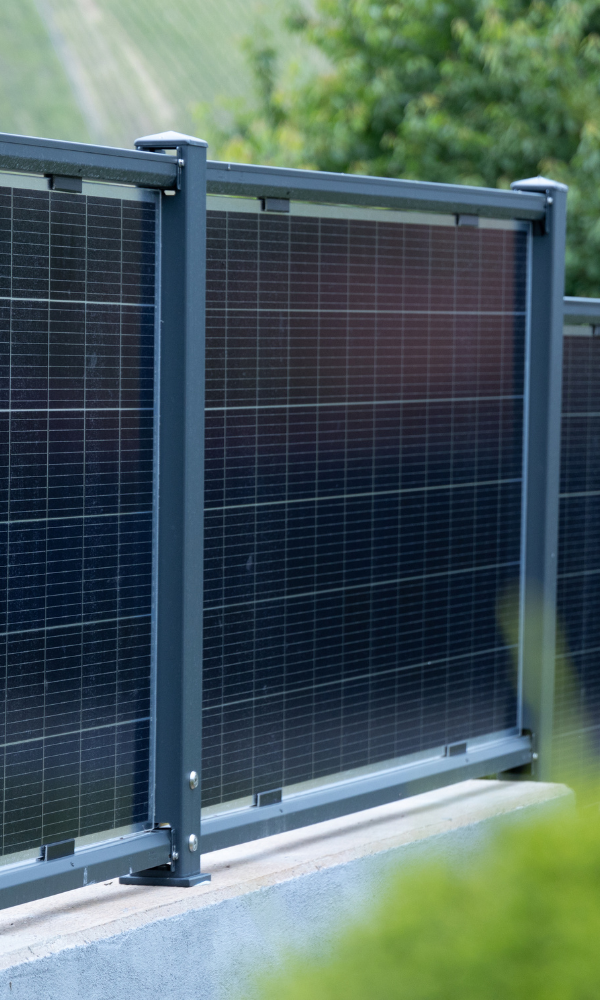
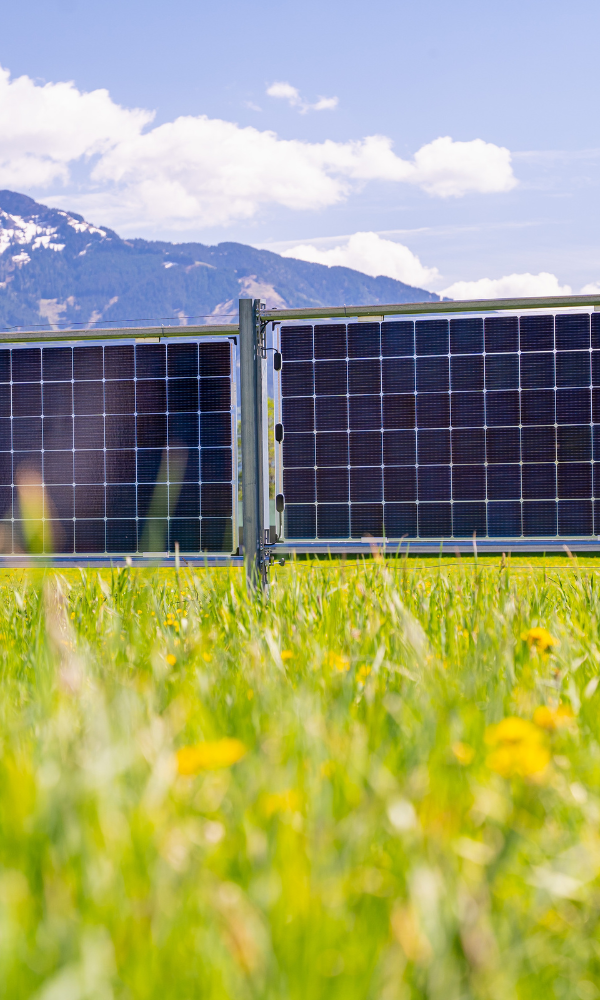
Vienna Energy Michael Horak Ansaat-Schafflerhof
Advantages of the solar fence from Next2Sun
Our vertical PV modules have many advantages over conventional systems, ensuring that your properties are enhanced at every level.
Opting for a sustainable energy source is not only a step towards environmental protection, but also a smart financial investment. The Next2Sun solar fence embodies this philosophy with its innovative design, which provides added value both ecologically and economically. Technological innovation and sustainable efficiency ensure multiple benefits that pay off.

Optimized power generation
Optimize your electricity yield and benefit from consistent power production.
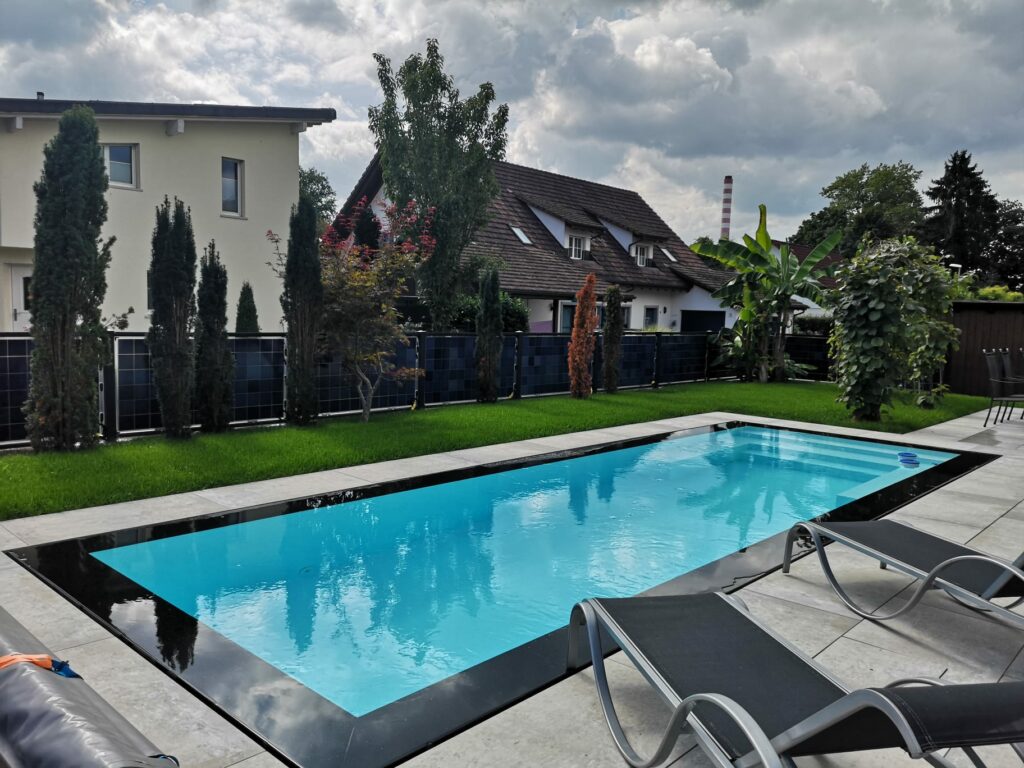
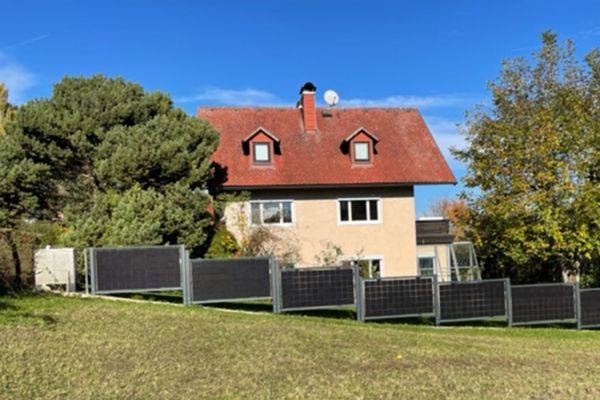

Aesthetic enclosure
Aesthetically enhance your areas and properties and increase their value.
Sustainable dual use
Independence from external energy sources is becoming increasingly important in view of rising energy costs and environmental policy requirements.
Standard solar fence
In contrast to the Premium version, the Standard version of Fence2Sun is industrial and robust and is a derivative of our Agri-PV system. Thanks to the modular design, different heights of up to 3 meters are possible. Longer posts can also be used for sloping terrain, allowing slopes of up to 11° to be overcome. For a higher electricity yield, two PV modules can be mounted on top of each other.
Gap closure:
The distance to the ground can also be optionally closed with a perforated plate, an aluminum plate or a mesh or double bar mat (for small animals) in the standard version.
For large animals, there is the option of attaching insulators for a grazing wire.
Mounting options:
Either driven steel profiles are used as cost-effective foundations.
However, concrete foundations are equally possible as an adaptation to local conditions.
Premium solar fence
The premium version is more aesthetic than the standard version and can be supplied galvanized or powder-coated in RAL7016 (anthracite).
The height of the fence segments can be gradually adjusted up to 2.50 meters.
Mounting options:
The Premium solar fence is available in three versions: “on-wall mounting”, “in-wall mounting” (between two wall elements) or anchoring with a “concrete point foundation” to place the solar fence directly in the meadow or grassland.
Gap closure:
The gap to the ground can optionally be closed with a “perforated plate”, a “mesh bar mat” or an “aluminum plate”.
This can be used to create an individual design or to prevent farm animals or certain pets from escaping/breaking out.
In the case of concrete walls, an existing slope of the terrain can be compensated by three different available steps (10, 15 or 20 cm).
Lifespan:
The frame design, which originates from the solar power plant sector, is designed for a long service life and high wind loads, as are the bifacial glass-glass solar modules used in the solar fence.

Our offer includes partnership support for large-scale projects and specialized enclosures.
For large projects and enclosures, we also offer:
- Itemisation as per DIN EN 1991
- Proof of foundations based on local conditions
- Client-specific special solutions
The full solar fence package
The complete package for solar fences includes a range of services, including advisory, project planning, support with subsidies, delivery of the installation material, foundation construction, as well as the installation of the frame, the modules and the final electrical installation by Next2Sun or a suitable Next2Sun partner.
In cooperation with our regional installation and consulting partners, you will achieve an optimal solution and implementation of your solar fence.
We offer you the following services:
- Consulting and design of the fence system
- Assistance with any funding
- Delivery of all mounting material
- Pile driving / making the foundations
- Rack and module assembly
- Electrical installation and commissioning
Guaranteed quality








Frequently asked questions
A solar fence uses vertically mounted, bifacial modules that capture sunlight on both sides to maximize energy yield. This design enables constant energy production, especially in the morning and evening hours.
By utilizing both sides of the panels, solar fences ensure constant energy production, even in diffuse light, making them a reliable solution for homeowners or businesses that want to generate clean energy without taking up extra space.
Next2Sun continues to drive this innovation with its solar fence, offering a 10% higher energy yield compared to conventional rooftop solar systems. The bifacial modules, paired with state-of-the-art cell technology, deliver market-leading performance while serving as an elegant property boundary.
The cost of a solar fence varies depending on the length, type of modules and installation requirements. Use our cost calculator to get an individual cost estimate and see how the solar fence will pay for itself over time.
Next2Sun’s bifacial solar fence uses sunlight from both sides, resulting in up to 10 % more electricity production in the morning and evening. This additional yield is particularly valuable as electricity prices tend to be higher outside peak load times, which further increases the efficiency of the system.
No, the fence does not have to be aligned directly towards the sun. The Next2Sun system works regardless of a specific orientation to the sun, as the modules are installed vertically and are light-sensitive (bifacial) on both sides. In addition, a natural albedo effect ensures effective reflection. The modules can be aligned in an east-west direction in order to generate electricity both in the morning and evening hours, which results in a favorable feed-in profile. A different orientation also provides good yields, but the exact orientation depends on the local conditions and is determined individually for each location.
The Next2Sun solar fence is ideal for various locations such as residential areas, commercial and industrial properties and farms. The vertical installation enables optimized use even on narrow or irregularly shaped plots where traditional photovoltaic systems would not be practical.
Your energy independence starts here!
Achieve up to 10 % higher electricity yields per installed kW compared to conventional ground-mounted systems

